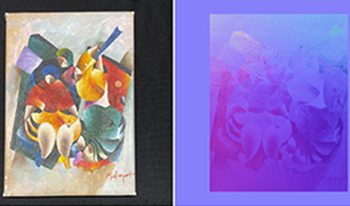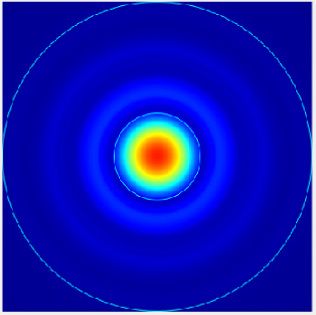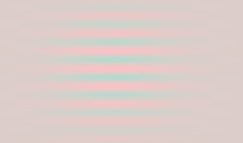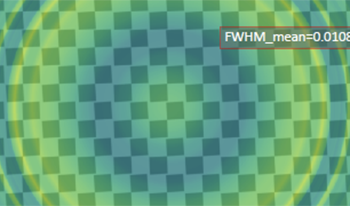
In this paper we introduce MISHA3D, a set of tools that enable 3D surface capture using the MISHA multispectral imaging system. MISHA3D uses a novel multispectral photometric stereo algorithm to estimate normal, height, and RGB albedo maps as part of the standard multispectral imaging workflow. The maps can be visualized and analyzed directly, or rendered as realistic, interactive digital surrogates using standard graphics APIs. Our hope is that these tools will significantly increase the usefulness of the MISHA system for librarians, curators, and scholars studying historical and cultural heritage artifacts.

Model-based approaches to imaging, such as specialized image enhancements in astronomy, facilitate explanations of relationships between observed inputs and computed outputs. These models may be expressed with extended matrix-vector (EMV) algebra, especially when they involve only scalars, vectors, and matrices, and with n-mode or index notations, when they involve multidimensional arrays, also called numeric tensors or, simply, tensors. Although this paper features an example, inspired by exoplanet imaging, that employs tensors to reveal (inverse) 2D fast Fourier transforms in an image enhancement model, the work is actually about the tensor algebra and software, or tensor frameworks, available for model-based imaging. The paper proposes a Ricci-notation tensor (RT) framework, comprising a dual-variant index notation, with Einstein summation convention, and codesigned object-oriented software, called the RTToolbox for MATLAB. Extensions to Ricci notation offer novel representations for entrywise, pagewise, and broadcasting operations popular in EMV frameworks for imaging. Complementing the EMV algebra computable with MATLAB, the RTToolbox demonstrates programmatic and computational efficiency via careful design of numeric tensor and dual-variant index classes. Compared to its closest competitor, also a numeric tensor framework that uses index notation, the RT framework enables superior ways to model imaging problems and, thereby, to develop solutions.

Smooth topological surfaces embedded in 4D create complex internal structures in their projected 3D figures. Often these 3D figures twist, turn, and fold back on themselves, leaving important properties behind the surface sheets. Triangle meshes are not well suited for illustrating such internal structures and their topological features. In this paper, we propose a new approach to visualize these internal structures by slicing the 4D surfaces in our dimensions and revealing the underlying 4D structures using their cross-sectional diagrams. We think of a 4D-embedded surface as a collection of 3D curves stacked and evolved in time, very much like a 3D movie in a time-elapse form; and our new approach is to translate a surface in 4-space into such a movie --- a sequence of time-lapse frames where successive terms in the sequence differ at most by a critical change. The visualization interface presented in this paper allows us to interactively define the longitudinal axis, and the automatic algorithms can partition the 4D surface into parallel slices and expose its internal structure by generating a time-lapse movie consisting of topologically meaningful cross-sectional diagrams from the representative slices. We have extracted movies from a range of known 4D mathematical surfaces with our approach. The results of the usability study show that the proposed slicing interface allows a mathematically true user experience with surfaces in four dimensions.

In this research we compare chromatic contrast sensitivity models for two separate datasets and for the pooled dataset. They were obtained from two studies employing a very similar experimental paradigm. The data represent threshold visibilities of chromatic Gabor patterns varying in spatial frequency, background chromaticity, direction of color modulation and luminance, at constant stimulus size. Using the extended data set, we reconfirm our previously reported finding that a model based on coloropponent contrast signals is an improvement over a cone contrast model. However, when linear background scaling in classic cone contrast is replaced by nonlinear background scaling, an improvement of almost similar size is obtained. The results of this study can be of interest for the development of vision models employing the processing of spatio-chromatic information.

Managing color on a particular imaging system is a wellunderstood challenge with a wealth of existing models, methods and techniques. In the case of printing systems, these tend to operate in the context of a single substrate, where managing color on every additional substrate is approach as a separate, detached problem. While such a mind-set works reasonably well in general, it breaks down when it comes to printing onto precolored textiles, such as pre-dyed fabrics. The present paper therefore introduces a family of approaches that support the use of multiple pre-colored textiles on a given printing system that also allow for a balance between characterization effort and color match accuracy. This, in turn provides solutions that can fit a variety of practical working patterns to maximize overall efficiency and performance.

We present a novel metric Spatial Recall Index to assess the performance of machine-learning (ML) algorithms for automotive applications, focusing on where in the image which performance occurs. Typical metrics like intersection-over-union (IoU), precisionrecallcurves or average precision (AP) quantify the performance over a whole database of images, neglecting spatial performance variations. But as the optics of camera systems are spatially variable over the field of view, the performance of ML-based algorithms is also a function of space, which we show in simulation: A realistic objective lens based on a Cooke-triplet that exhibits typical optical aberrations like astigmatism and chromatic aberration, all variable over field, is modeled. The model is then applied to a subset of the BDD100k dataset with spatially-varying kernels. We then quantify local changes in the performance of the pre-trained Mask R-CNN algorithm. Our examples demonstrate the spatial dependence of the performance of ML-based algorithms from the optical quality over field, highlighting the need to take the spatial dimension into account when training ML-based algorithms, especially when looking forward to autonomous driving applications.

Virtual crowds for non-combative environments play an important role in modern military operations and often create complications for the combatant forces involved. To address this problem, we are developing crowd simulation capable of generating crowds of non-combative civilians that exhibit a variety of individual and group behaviors at a different level of fidelity. Commercial game technology is used for creating an experimental setup to model an urban megacity environment and the physical behaviors of human characters that make up the crowd. The main objective of this work is to verify the feasibility of designing a collaborative virtual environment (CVE) and its usability for training security agents to respond to emergency situations like active shooter events, bomb blasts, fire and smoke. We present a hybrid (human-artificial) platform where experiments for disaster response can be performed in CVE by including AI agents and User-controlled agents. AI agents are computer controlled agents to include behaviors such as hostile agents, non-hostile agents, leader following agents, goal following agents, selfish agents, and fuzzy agents. User-controlled agents are autonomous agents for specific situation roles such as police officer, medic, firefighter, and swat official. The novelty of our work lies in modeling behaviors for AI agents or computer-controlled agents so that they can interact with user-controlled agents in an immersive training environment for emergency response and decision making. The hybrid platform aids in creating an experimental setup to study human behavior in a megacity for emergency response, decision-making strategies, and what-if scenarios.

The increased replication of human behavior with virtual agents and proxies in a multi-user or collaborated virtual reality environment (CVE) has influenced the eruption of scholastic research and training. The capabilities of the user experience for emergency response and training in emergency and catastrophic situations may be highly influenced by the use of computer bots, avatar, and virtual agents. Our contribution and proposal for the concerted collaborated Virtual Reality nightclub environment consequently warrants the flexibility to run manifold scenarios and evacuation drills in reaction to emergency and disaster preparedness. Modeling such an environment is very essential because it helps emulate the emergencies we experience in our routine lives and provide a learning platform towards the preparation of extreme events. The results of the user study to measure presence in the VE using presence questionnaire (PQ) are discussed in detail, and it was found that there is a consistent positive relation between presence and task performance in VEs. The results further suggest that most users feel that this application could be a good tool for education and training purposes.

Abstract Marbling is a recurrent print defect that can be observed on polyvinyl(chloride) (PVC) film prints. It can be defined as undesired irregularity in print, which gives a texture to a solid area. Unlike mottling, marbling is a high frequency and quite regular defect, which can have many causes, whose identification and removal rely on accurate and reliable quantification of marbling on printed PVC substrates. Moreover, the evaluation of this defect must agree with human perception. The aim of this article is to evaluate the use of methods presented in the literature for mottle characterization on printed paper in order to quantify marbling on printed PVC film. Two methods, ISO standard and frequency analysis (based on Fourier transform), were used in this study to characterize a set of PVC printed substrates with increasing marbling. The resulting marbling indices were compared to visual print marbling assessment. The results demonstrated that methods applied to quantify mottle on paper can be transposed to evaluate marbling on printed PVC films.